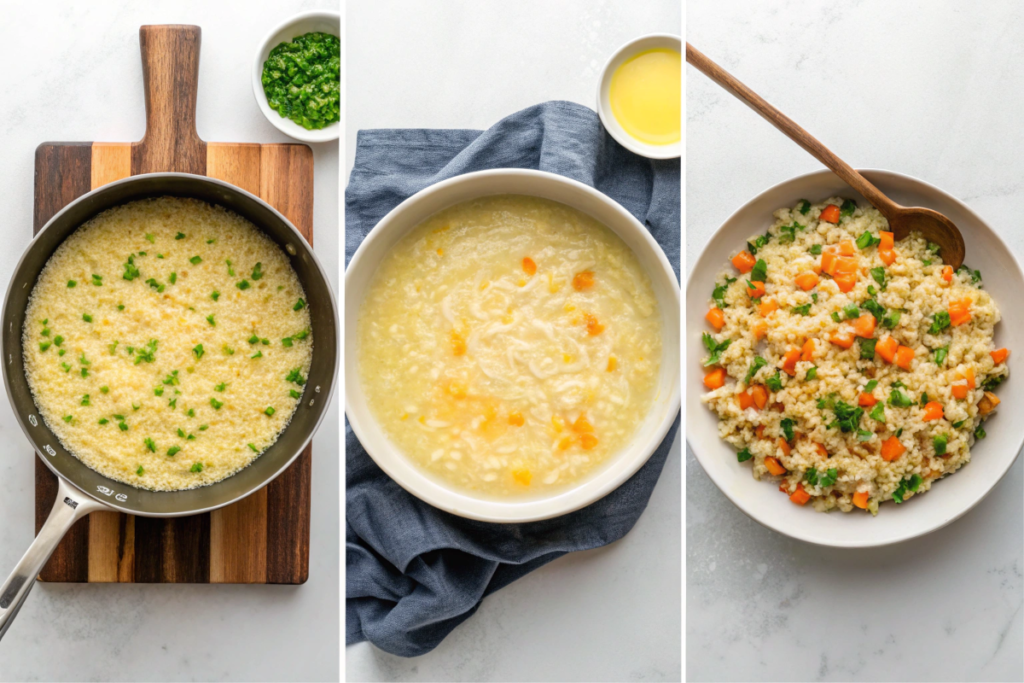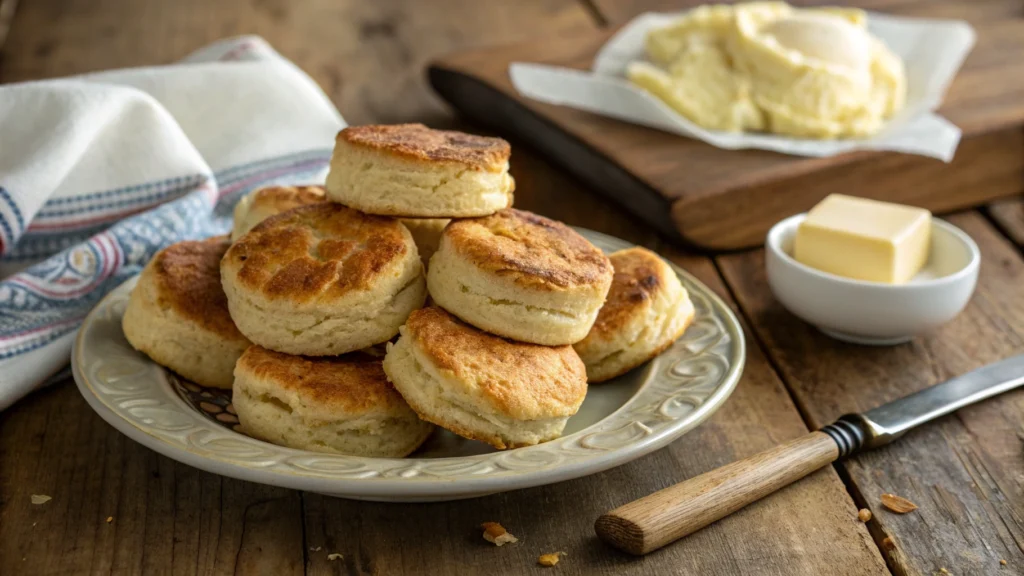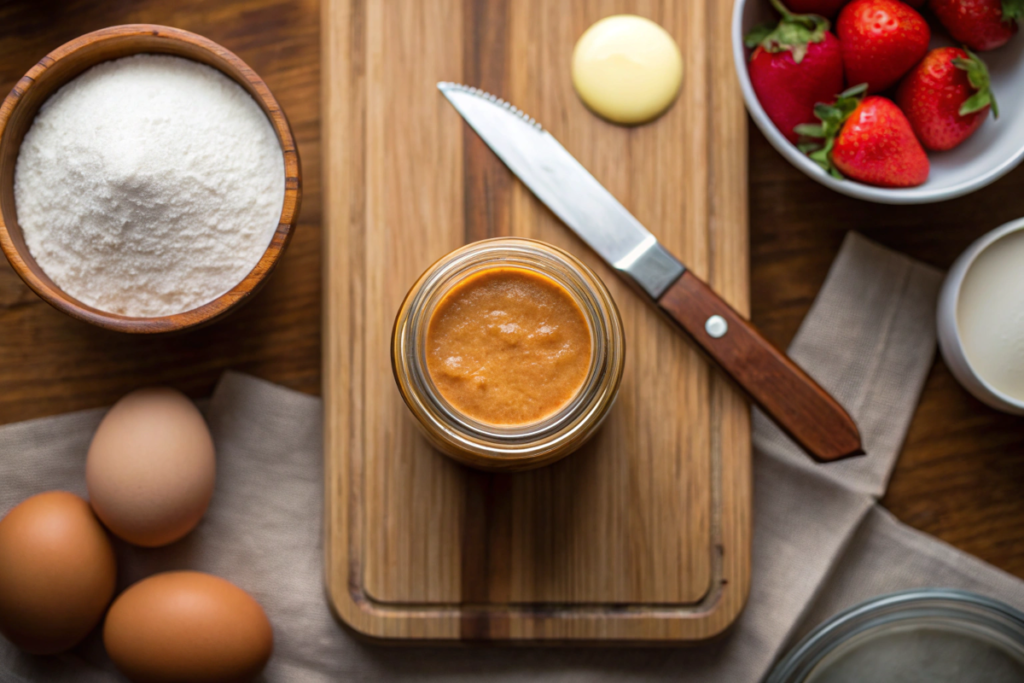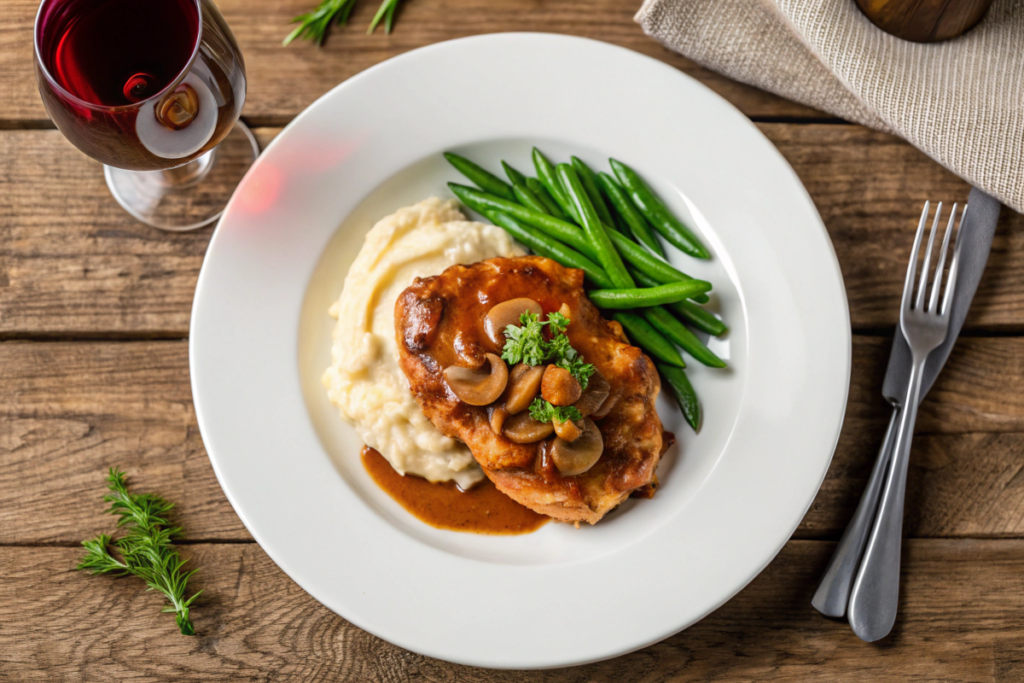Chicken Marsala is a beloved Italian-American dish renowned for its rich flavors and elegant presentation. But what do you serve with Chicken Marsala?
This comprehensive guide explores the best side dishes and pairings that complement this savory dish. Whether you’re hosting a dinner party or enjoying a cozy meal at home, understanding the perfect accompaniments can elevate your Chicken Marsala experience. For more ideas, check out what to serve with Chicken Marbella Ina Garten for inspiration on Mediterranean-style pairings.
Moreover, we’ll delve into classic and creative side dishes, vegetable-based pairings, grain-based options, bread and rolls, salad choices, and delightful desserts. Additionally, you’ll find tips on creating a balanced menu and selecting the right beverages. By the end of this guide, you’ll have a complete menu to impress your guests and enhance your Chicken Marsala dinners.
Introduction to Chicken Marsala
What is Chicken Marsala?
Chicken Marsala is a flavorful dish made with chicken breasts sautéed and served in a rich sauce of Marsala wine, mushrooms, and herbs. Originating from Italian cuisine, Marsala wine provides a sweet and robust flavor that perfectly complements the tender chicken. This dish strikes a balance between savory and sweet, making it a favorite in both home kitchens and upscale restaurants.
The Flavor Profile of Chicken Marsala
The unique flavor profile of Chicken Marsala lies in the combination of savory chicken, earthy mushrooms, and the sweet, fortified Marsala wine. This harmonious blend of ingredients creates a dish that’s both comforting and sophisticated. Additionally, herbs like thyme and garlic add depth, enhancing the overall taste and aroma.
Why Side Dishes Matter for Chicken Marsala
Choosing the right side dishes is crucial for balancing the rich flavors of Chicken Marsala. Not only do they complement and enhance the main dish, but they also provide a well-rounded and satisfying meal.
Furthermore, the right sides can add texture, flavor contrast, and nutritional balance to your dinner, ensuring that every component works together seamlessly.
Classic Side Dishes for Chicken Marsala
Garlic Mashed Potatoes
Garlic mashed potatoes are a timeless side that pairs beautifully with Chicken Marsala. This creamy and flavorful base absorbs the savory Marsala sauce, making each bite delicious. To prepare:
- Boil the Potatoes: Peel and boil potatoes until tender.
- Mash with Garlic: Mash the potatoes with roasted garlic, butter, and a splash of milk for a smooth texture.
- Season to Taste: Add salt and pepper to enhance the flavor.
Creamy Polenta
Creamy polenta is another classic side that complements the rich sauce of Chicken Marsala. Its silky and comforting texture makes it an ideal pairing. Here’s how to make it:
- Cook the Polenta: Bring water or chicken broth to a boil, then gradually whisk in polenta.
- Stir Continuously: Cook until the polenta thickens, stirring frequently to prevent lumps.
- Finish with Butter and Cheese: Stir in butter and grated Parmesan for added richness.
Buttered Egg Noodles
Buttered egg noodles offer a simple yet delicious side for Chicken Marsala. This light and versatile option complements the main dish without overpowering it. To prepare:
- Cook the Noodles: Boil egg noodles until al dente.
- Butter and Season: Drain and toss with melted butter, salt, and a sprinkle of parsley for freshness.
- Serve Warm: Serve immediately alongside your Chicken Marsala.
Vegetable Sides for Chicken Marsala
Sautéed Green Beans with Almonds
Sautéed green beans with almonds add a crunchy and nutty element to your meal. This fresh and vibrant contrast enhances the rich Chicken Marsala. To make:
- Blanch the Green Beans: Boil green beans until tender-crisp, then plunge into ice water.
- Sauté with Almonds: In a skillet, sauté green beans with sliced almonds and a touch of garlic.
- Season and Serve: Add salt, pepper, and a squeeze of lemon juice before serving.
Roasted Brussels Sprouts with Balsamic Glaze
Roasted Brussels sprouts with balsamic glaze offer a sweet and tangy side dish that pairs well with Chicken Marsala. Their caramelized flavor enhances the meal beautifully. Here’s how to prepare:
- Prepare the Brussels Sprouts: Trim and halve Brussels sprouts, then toss with olive oil, salt, and pepper.
- Roast: Spread them on a baking sheet and roast at 400°F (200°C) until crispy and golden.
- Drizzle Balsamic Glaze: Reduce balsamic vinegar until thickened and drizzle over the roasted sprouts.
Steamed Asparagus with Lemon Butter
Steamed asparagus with lemon butter is a light and elegant side for Chicken Marsala. This refreshing and zesty touch complements your meal perfectly. To prepare:
- Steam the Asparagus: Trim the ends and steam asparagus until tender.
- Make Lemon Butter: Melt butter and mix in fresh lemon juice and zest.
- Toss and Serve: Drizzle the lemon butter over the asparagus and garnish with parsley.

Grain-Based Pairings
Parmesan Risotto
Parmesan risotto is a creamy and luxurious side that pairs perfectly with Chicken Marsala. Its rich and savory flavors enhance the meal wonderfully. To make:
- Sauté Onions and Arborio Rice: In a pot, sauté finely chopped onions until translucent, then add Arborio rice and cook until slightly toasted.
- Add Broth Gradually: Gradually add warm chicken broth, stirring continuously until the rice is creamy and cooked through.
- Finish with Parmesan: Stir in grated Parmesan cheese and a knob of butter for extra creaminess.
Wild Rice Pilaf
Wild rice pilaf provides a hearty and flavorful side for Chicken Marsala. Its texture and depth add a substantial element to your meal. Here’s how to prepare:
- Cook the Wild Rice: Rinse wild rice and cook according to package instructions.
- Add Flavorings: In a separate pan, sauté onions, celery, and carrots, then mix into the cooked rice.
- Season and Serve: Add herbs like thyme and parsley, and season with salt and pepper.
Couscous with Fresh Herbs
Couscous with fresh herbs is a light and versatile side that complements the bold flavors of Chicken Marsala. This refreshing and aromatic addition enhances your meal. To make:
- Prepare the Couscous: Boil water or chicken broth and pour over couscous in a bowl. Cover and let sit until the liquid is absorbed.
- Fluff and Add Herbs: Fluff the couscous with a fork and stir in chopped fresh herbs like parsley and mint.
- Season to Taste: Add olive oil, lemon juice, salt, and pepper for enhanced flavor.

Bread and Rolls
Crusty Artisan Bread
Crusty artisan bread is perfect for soaking up the delicious Marsala sauce. Its satisfying crunch and hearty base make it an excellent addition to your meal. To serve:
- Choose a Quality Bread: Opt for a loaf with a crispy crust and soft interior.
- Slice and Serve: Slice the bread and serve warm with a drizzle of olive oil or a spread of herb butter.
- Pair with Chicken Marsala: Use the bread to dip into the sauce for an added layer of flavor.
Garlic Knots
Garlic knots are a flavorful and easy-to-make side that pairs wonderfully with Chicken Marsala. Their garlicky and buttery taste complements the main dish perfectly. To prepare:
- Make the Dough: Use store-bought pizza dough or homemade dough.
- Shape the Knots: Roll the dough into small knots and place on a baking sheet.
- Bake and Season: Bake until golden, then brush with melted butter mixed with minced garlic and parsley.
Focaccia with Rosemary and Olive Oil
Focaccia with rosemary and olive oil is an aromatic and savory side for Chicken Marsala. Its fragrant and flavorful touch enhances your meal beautifully. Here’s how to make:
- Prepare the Dough: Use store-bought or homemade focaccia dough, stretching it into a flat shape.
- Add Toppings: Press fresh rosemary leaves into the dough and drizzle with high-quality olive oil.
- Bake: Bake until golden and crispy, then slice and serve warm.
Salad Options
Caesar Salad with Parmesan Shavings
A classic Caesar salad with Parmesan shavings is a refreshing side that balances the richness of Chicken Marsala. Its crisp and tangy contrast enhances the main dish. To make:
- Prepare the Dressing: Combine mayonnaise, lemon juice, garlic, Worcestershire sauce, and anchovies to create the dressing.
- Toss the Salad: Mix romaine lettuce with croutons, Parmesan shavings, and the dressing.
- Serve Immediately: Serve the salad chilled alongside your Chicken Marsala.
Arugula Salad with Lemon Vinaigrette
An arugula salad with lemon vinaigrette provides a peppery and tangy side for Chicken Marsala. This fresh and vibrant element adds a delightful touch to your meal. To prepare:
- Prepare the Arugula: Wash and dry fresh arugula leaves.
- Make the Vinaigrette: Whisk together lemon juice, olive oil, Dijon mustard, salt, and pepper.
- Toss and Serve: Toss the arugula with the vinaigrette and garnish with shaved Parmesan or toasted nuts.
Caprese Salad with Fresh Basil
A Caprese salad with fresh basil is a simple and elegant side that complements Chicken Marsala. Its light and flavorful addition enhances your meal beautifully. To make:
- Slice Tomatoes and Mozzarella: Arrange slices of ripe tomatoes and fresh mozzarella on a plate.
- Add Fresh Basil: Tuck whole basil leaves between the slices.
- Drizzle and Season: Drizzle with extra virgin olive oil and balsamic glaze, then season with salt and pepper.
Creative Side Dish Ideas
Truffle Mac and Cheese
Truffle mac and cheese is a luxurious and indulgent side for Chicken Marsala. Its rich and earthy flavor adds sophistication to your meal. To prepare:
- Cook the Pasta: Boil elbow macaroni until al dente.
- Make the Cheese Sauce: Melt butter, add flour to create a roux, then slowly whisk in milk and shredded cheese until smooth.
- Add Truffle Oil: Stir in a drizzle of truffle oil for an enhanced flavor.
- Combine and Serve: Mix the cheese sauce with the cooked pasta and serve warm.
Grilled Zucchini with Parmesan
Grilled zucchini with Parmesan is a tasty and nutritious side that pairs well with Chicken Marsala. Its smoky and savory contrast complements the main dish perfectly. To make:
- Prepare the Zucchini: Slice zucchini lengthwise and brush with olive oil.
- Grill the Zucchini: Grill on medium-high heat until tender and charred.
- Add Parmesan: Sprinkle grated Parmesan cheese over the grilled zucchini before serving.
Ratatouille
Ratatouille is a vibrant and flavorful vegetable dish that complements the savory notes of Chicken Marsala. This colorful and hearty side enhances the overall meal beautifully. To prepare:
- Chop the Vegetables: Dice eggplant, zucchini, bell peppers, tomatoes, and onions into uniform pieces.
- Sauté the Aromatics: In a large pot, sauté garlic and onions in olive oil until translucent.
- Add the Vegetables: Add the chopped vegetables and herbs like thyme and oregano.
- Simmer: Cook until all vegetables are tender and the flavors meld together.
- Serve: Garnish with fresh basil or parsley before serving.
Drinks to Pair with Chicken Marsala
Wine Pairings (Marsala, Chardonnay, Pinot Noir)
Choosing the right wine is essential for enhancing the flavors of Chicken Marsala. Wines such as Marsala, Chardonnay, and Pinot Noir offer excellent complements:
- Marsala: The dish’s namesake wine intensifies the Marsala sauce’s sweetness and richness.
- Chardonnay: A buttery Chardonnay pairs well with the creamy sauce.
- Pinot Noir: A light Pinot Noir balances the dish’s savory and sweet elements.
Non-Alcoholic Beverages (Sparkling Water, Lemonade)
Non-alcoholic beverages provide refreshing options to accompany Chicken Marsala. Drinks like sparkling water and lemonade offer a crisp and tangy contrast:
- Sparkling Water: Adds a light and effervescent touch to cleanse the palate.
- Lemonade: Offers a sweet and tart flavor that complements the dish’s richness.
Cocktails to Complement Chicken Marsala
Cocktails can add a sophisticated touch to your Chicken Marsala dinner. Consider the following options:
- Negroni: A classic Italian cocktail with a bitter-sweet profile.
- Moscow Mule: A refreshing mix of vodka, ginger beer, and lime.
- Martini: A sleek and elegant choice to enhance the meal’s sophistication.
Desserts to Finish the Meal
Tiramisu
Tiramisu is a classic Italian dessert that pairs wonderfully with Chicken Marsala. Its creamy and coffee-flavored finish provides a delightful end to your meal. To make:
- Prepare the Coffee Mixture: Brew strong coffee and mix with a bit of Marsala wine.
- Assemble the Layers: Dip ladyfingers in the coffee mixture and layer them in a dish with mascarpone cheese.
- Chill and Serve: Refrigerate until set and dust with cocoa powder before serving.
Panna Cotta
Panna cotta is a smooth and creamy dessert that complements the flavors of Chicken Marsala. This light and elegant end to your meal is both simple and impressive. To make:
- Prepare the Gelatin: Dissolve gelatin in warm water.
- Mix the Cream: Combine cream, sugar, and vanilla extract in a saucepan and heat until sugar dissolves.
- Combine and Chill: Mix in the gelatin and pour into molds. Refrigerate until set.
- Serve with Berries: Top with fresh berries or a berry coulis before serving.
Lemon Sorbet
Lemon sorbet offers a refreshing and tangy dessert option to cleanse the palate after a rich meal. Its bright and zesty finish perfectly rounds off your Chicken Marsala dinner. To make:
- Prepare the Simple Syrup: Heat water and sugar until dissolved, then cool.
- Mix with Lemon Juice: Combine the simple syrup with fresh lemon juice and zest.
- Freeze: Pour the mixture into an ice cream maker and churn until smooth, then freeze until firm.
- Serve Chilled: Scoop and serve in chilled bowls.
Tips for Creating a Balanced Menu
Balancing Flavors and Textures
Creating a balanced menu involves combining different flavors and textures. For instance, pairing a creamy side like mashed potatoes with a crunchy vegetable side such as roasted Brussels sprouts ensures that each bite is enjoyable and the meal remains satisfying.
Incorporating Seasonal Ingredients
Using seasonal ingredients enhances the freshness and flavor of your meal. Selecting vegetables and fruits that are at their peak not only provides the best taste and nutritional value but also adds variety and keeps your menu interesting throughout the year.
Considering Dietary Restrictions
Taking into account dietary restrictions ensures that all your guests can enjoy the meal. Offering a variety of side dishes that cater to different needs, such as gluten-free, vegan, or low-fat options, makes your Chicken Marsala dinner accessible and enjoyable for everyone.
Frequently Asked Questions About Best Pairings With Chicken Marsala
What Pasta Goes Best with Chicken Marsala?
The best pasta for Chicken Marsala is linguine or fettuccine. These types of pasta have a flat shape that holds the Marsala sauce well, providing a satisfying and flavorful combination.
Can Chicken Marsala Be Paired with Rice?
Yes, Chicken Marsala pairs excellently with rice. Serving it over a bed of creamy risotto or fluffy white rice enhances the meal by absorbing the rich Marsala sauce, making each bite delicious.
Are There Vegan or Gluten-Free Side Options?
Absolutely, there are vegan and gluten-free side options available. Dishes like roasted vegetables, quinoa salad, and gluten-free pasta ensure that guests with dietary restrictions can enjoy the meal without compromise.
Conclusion
In conclusion, the best side dishes for Chicken Marsala include classic options like garlic mashed potatoes and creamy polenta, as well as vegetable sides such as sautéed green beans and roasted Brussels sprouts. This variety of choices allows you to complement and enhance your Chicken Marsala dinner beautifully.
To create a memorable meal, focus on balancing flavors and textures, incorporating seasonal ingredients, and considering dietary restrictions. These final tips ensure that your Chicken Marsala dinner is enjoyable, satisfying, and inclusive for all your guests.










